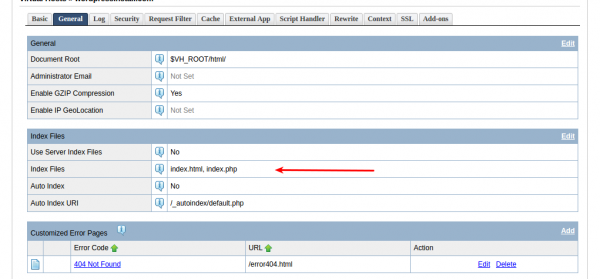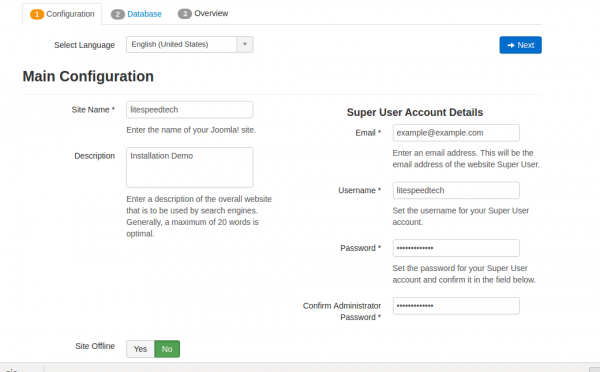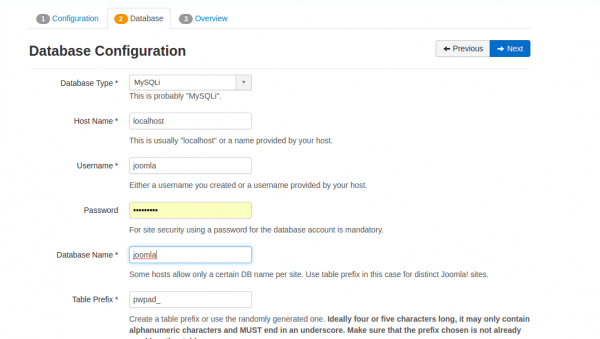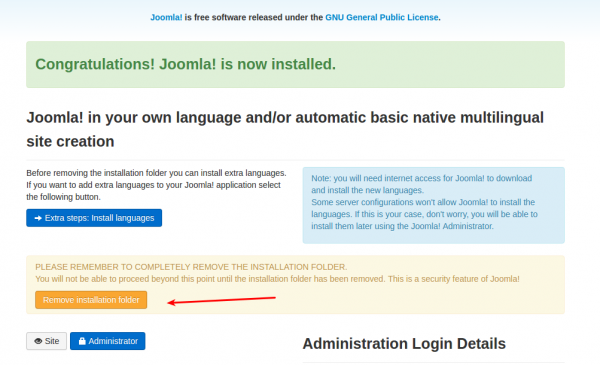This is an old revision of the document!
Joomla Installation
This guide will explain how to get up and running with Joomla on LiteSpeed Web Server.
Install PHP modules
The easiest way to install PHP for LiteSpeed is through our CentOS repository. If the LiteSpeed Repository was not installed and enabled during the web server installation, follow this guide to install and enable the LiteSpeed Repository.
Step 1.Install PHP
You can install some of the most commonly-used PHP 7.1 packages and modules for LiteSpeed. Use the following command:
sudo yum install lsphp71 lsphp71-mysqlnd lsphp71-common lsphp71-gd lsphp71-pdo lsphp71-process lsphp71-mbstring lsphp71-mcrypt lsphp71-opcache lsphp71-bcmath lsphp71-xml lsphp71-soap lsphp71-json -y
Step 2.Setup PHP
Visit http://your_server_IP:7080. Navigate to Server Configuration > External app, then click the second icon Edit on the right hand side in order to edit this application.
Modify:
- Name: lsphp →
lsphp71 - Command: $SERVER_ROOT/fcgi-bin/lsphp5 →
$SERVER_ROOT/lsphp71/bin/lsphp
Step 3.Restart LSWS
When you are finished, click the Save icon to save your changes, then click the Graceful Restart button.
Step 4. PHP Verification
Visit http://your_server_IP/phpinfo.php and make sure PHP Version shows 7.1.x.
Mariadb Installation:
Install MariaDB:
sudo yum install mariadb-server sudo systemctl start mariadb
Set new password:
/usr/bin/mysql_secure_installation
Enter $yourpassword
Create Drupal DB Account
Create the Joomla database and your Joomla user/password:
mysql -u root -p$yourmysqlpassword create database joomla; grant all privileges on joomla.* to joomla@localhost identified by 'joomla'; exit;
Note: For security purposes, you should use a Joomla username and password that are different than our example.
Set Index File
An index file needs to be set in Litespeed web admin console. Navigate to Virtual Hosts > Select Virtual Host from List > General > Index Files, click Edit on top right corner, now inside Index Files box enter index.html,index.php.
Download and Extract Joomla
To illustrate setting up Joomla on a vhost we'll use the default virtual host, “Example”. You can download Joomla from their official download page.
Please note that document root of 'Example' virtual host is /usr/local/lsws/Example/http/
unzip Joomla_x.x.x-Stable-Full_Package.zip
Joomla Installation
Open browser with URL http://server_IP:8088/
This will start Joomla web installer and it will look something like this:
On this page installer asks some general questions about the site, you can fill in as required, an example configuration is given below:
- Site Name: Litespeedtech
- Description: Installation Demo
- Email: example@example.com
- Username: litespeedtech
- Password: litespeedtech
Once done, click 'Next'.
Database Configuration
We've already created database above, just enter details and click 'Next'.
Overview
This is the last step before Joomla installer starts the installation process, usually on this window you don't need to do anything. Installer will check that if all server side requirements are met and if you have correctly followed the guide then it should not give you any errors and you are free to click 'Install'.
Remove Installation Folder
Once the installation is successful you can remove the installation folder.
You can not use Joomla installation until installation folder is removed, you can also remove installation folder from the command line using:
rm -rf installation
Now if you go to http://server_IP:8088/, you will see Joomla home page, and administration area can be found at http://server_IP:8088/administrator



